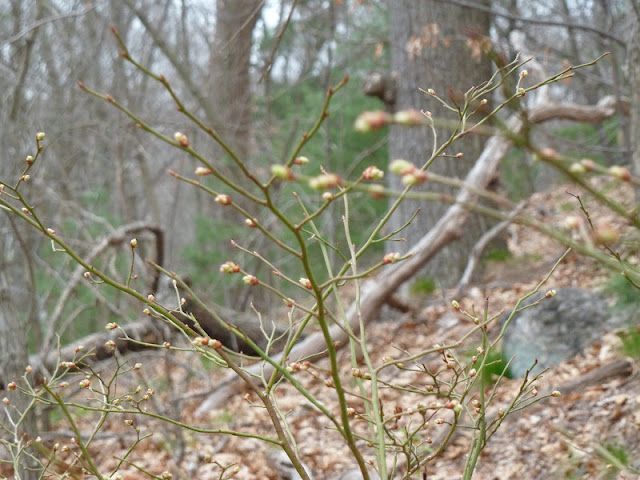In a somewhat less than great mood today, I dropped my son off at a friends house and then walked home via Franklin park. The upper entrance on Forest Hill Rd takes you right into the park, but it also brings you to some of the more neglected and overgrown areas. The invasive plants are fighting each other there, mostly on the ground and understory levels, and for a plant lover like me that can be challenging to watch as well, especially if you are already in a bad mood. But there are still tall oaks, and pines, and beeches and black birches, and few maples here and there.
Bishopsweed or goutweed is fighting the garlic mustard for ground space.
Japanese knotweed is rearing its ugly head.
The only natives right here are Poison ivy and brambles, which aren't exactly the friendliest ones.
Sometimes people plant garden stuff: Daylillies, spring bulbs, vincas.
The forsythia sure brightened things up on this gray day
and I guess it's positive to see one invasive fight another, Bittersweet here trying to strangle Buckthorn.
A damp, low area, could have been a spring vernal pool with frogs creeking right now. Instead, it's a mucky dirty dump area. In a few months the knotweed will grow 10 ft tall here.
Although this nest proved that some creatures enjoy the environment right here.
And fuzzy sumac were found farther from the swamp.
Logs covered in green are still some of the most colorful things this time of year.
And little shinleaf, evergreen wildflower, looks cute as ever. Hope new flowers will form soon!
I looked for Canada mayflower and Sarsaparilla, the other wildflowers that I have seen here, but didn't see any signs of them yet.
Not a great picture, but this is the hairy woodpecker, one of my friends from winter bird feeding. You can tell that it's a hairy rather than a downy because of the long pointy beak.
Roxbury Puddingstone. I will quote Wikipedia here (although wish I had a real, old-fashioned, Book to quote), since I have not read up enough on this:
"Pudding stone or Plum-pudding stone, is a popular name applied to a conglomerate that consists of distinctly rounded pebbles whose colors contrast sharply with the color of the finer-grained, often sandy, matrix or cement surrounding them." This is the most common form of rock you will found around here. When I first arrived in town I thought it was construction debris! Then I thought it might be traces from the Ice age, when rocks got rolled around and smoothed out by the heavy ice layers. But of course, it is much much older than that. At some point in time, rounded rocks of different sizes and mineral origins were encapsuled in a different kind of rock. This particular Puddingstone is common not only in Roxbury or Jamaica Plain, but all over southeast Boston. Or, I should say, under.
More upland I found blueberry bushes with big buds.
I believe the upper and the lower pictures show two varieties of lowbush blueberries.
This is an old Highbush blueberry - you can tell by the "kidney bean gall", a deformed growth caused by an insect, only found on Blueberry.
And finally I came to see what I knew would brighten my day: an old flowering dogwood.
These adorable buds were almost opening up as I was there.
It is completely amazing that this tree is still alive, since it got severely broken during the previous winter and its heavy snow. But many branches are leafing out, and in a week or so the flowers will be open.
Don't miss it!

























Enjoying your guided tour through Franklin Park, thanks.
ReplyDelete